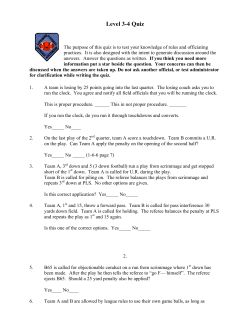
How to write an Introduction Georg Gottlob
How to write an Introduction Georg Gottlob Facts about introductions • The „selling“ phase of your paper: The body of the paper is your product, the introduction sells it to the potential reader or to the referee. • If the introduction is not well-written, the rest of the paper will not be read. • Referees and readers form their opinion on your paper while reading the introduction. This opinion cannot be improved in the paper body! It can be confirmed or it can be worsened... Important findings Many referees of conference papers read only the abstract and the introduction. They make quick „sanity“ checks to the paper body but do not read it in detail. They look carefully at the references in order to see whether related work they happen to know is cited, and whether their own work is cited. Official aims of the introduction • • • • Telling what your paper is all about Situating your paper in a scientific context Summarizing your results Giving a „roadmap“ of your paper Official aims of the introduction • • • • Telling what your paper is all about Situating your paper in a scientific context Summarizing your results Giving a „roadmap“ of your paper These are indeed important aims that must be fulfilled. However, ther are, in addition, important secret aims! Secret aims • Raising the interest of the referee/reader • Raising the curiosity of the referee • Convincing the referee that you have solved an important problem. • Convincing the referee that your results are: - innovative - nontrivial - useful - scholarly obtained • Helping the referee to accept your paper by providing arguments s/he can use in the report. Empathy The most important gift for writing an introduction is empathy: • • • Be able to feel and suffer with the referee Be able to see with the eyes of the referee Understand the needs of a referee Empathy is a gift, but it can also be trained... How to raise the reader‘s curiosity? How to raise the reader‘s curiosity? By dramatizing... 1. There is this important problem everybody would like to solve. 2. There are serious obstacles towards a solution . 3. By brave research I fight the obstacles and solved this problem How to raise the reader‘s curiosity? By dramatizing... 1. There is this important problem everybody would like to solve. The princess/prince to be conquisted and married (by the refree) 2. There are serious obstacles towards a solution . The dragon 3. By brave research I fight the obstacles and solved this problem The fight and victory Relevance - Clearly identify the problem you are going to tackle - Explain why it is relevant to many others. Again, you may use dramatization. Even the most boring research can be dramatized in the introduction. For example: You make an experimental evaluation and comparison of two heuristics for solving NP-hard problems. Dramatization approach: „The user is in a great dilemma...“ „Our systematic study provides useful guidelines...“ Relevance - Clearly identify the problem you are going to tackle - Explain why it is relevant to many others. Again, you may use dramatization. Even the most boring research can be dramatized in the introduction. For example: You make an experimental evaluation and comparison of two heuristics for solving NP-hard problems. Dramatization approach: „The user is in a great dilemma...“ „Our systematic study provides useful guidelines...“ Suggestive terms, ok, but do not exaggerate! Possible structure of intro • One sentence or short paragraph about what the paper is about and a mini-summary of your main results. (1 par) • Introducing the important problem you solve, give some (possibly simplified) definitions (1 par) • Why is this problem important, who has attempted to solve it, which solutions exist so far, why aren‘t they sufficient, why are we left with a dilemma, what are the main obstacles, why would it be useful to fight them. What would be the benefit of a (better) solution. (1/2 page) • Elaboration on single obstacles and how you overcome them. • Short description of results and their advantage and usefulness in chronological order. • Some remarks about the nontriviality of the solution • Summary of main results in form of a dotlist • Further related work and a sentence about future plans • Roadmap „This paper is organized as follows...“
© Copyright 2025





















